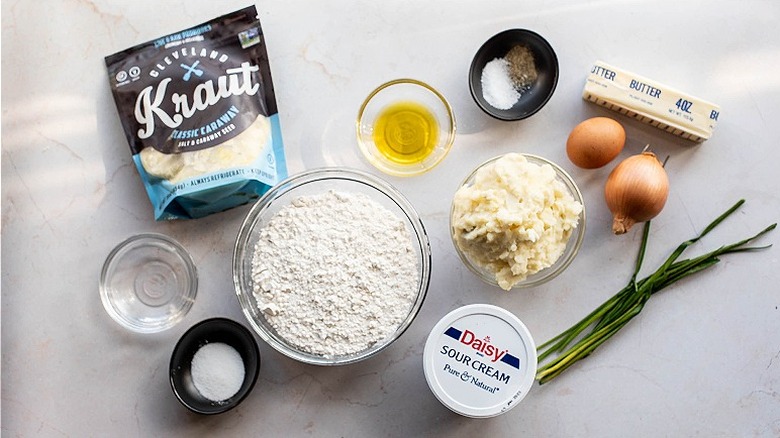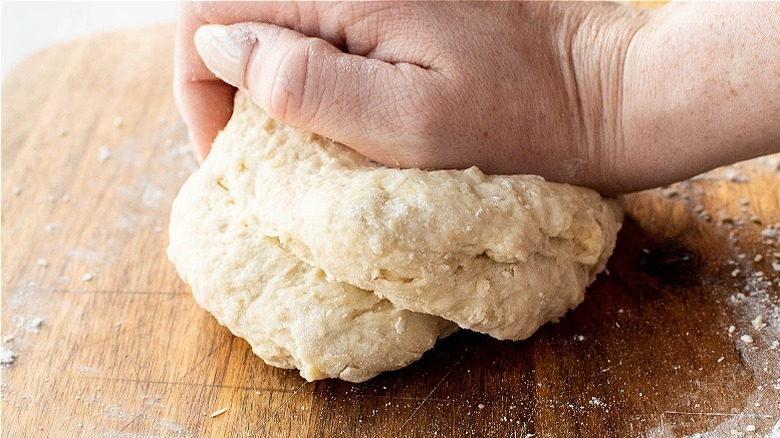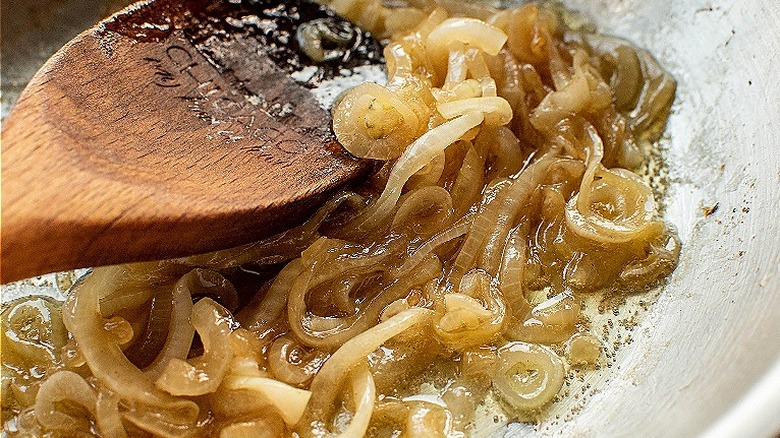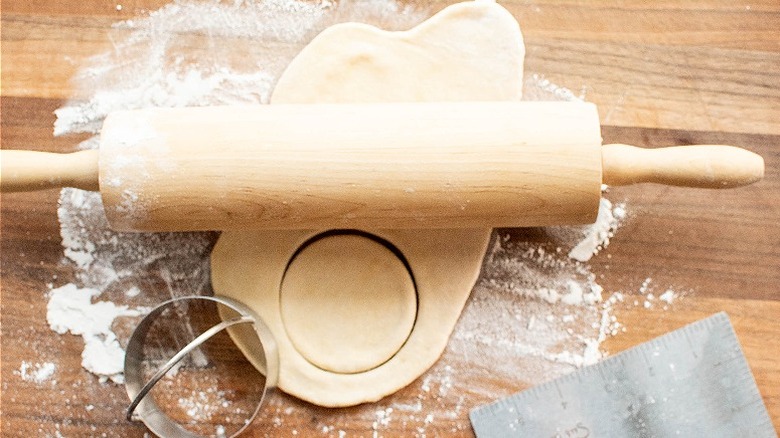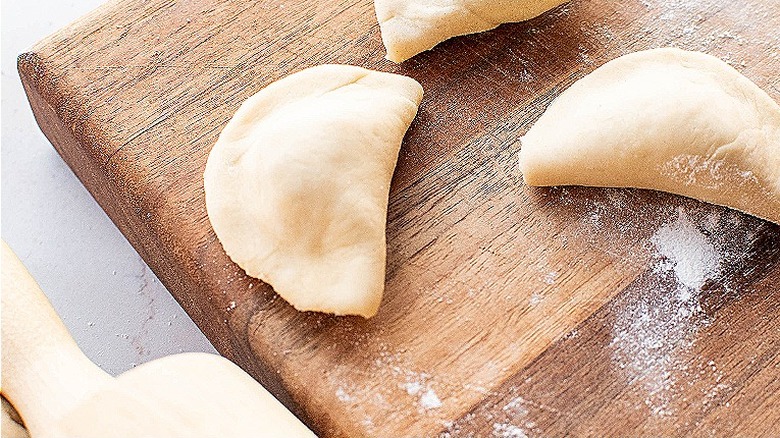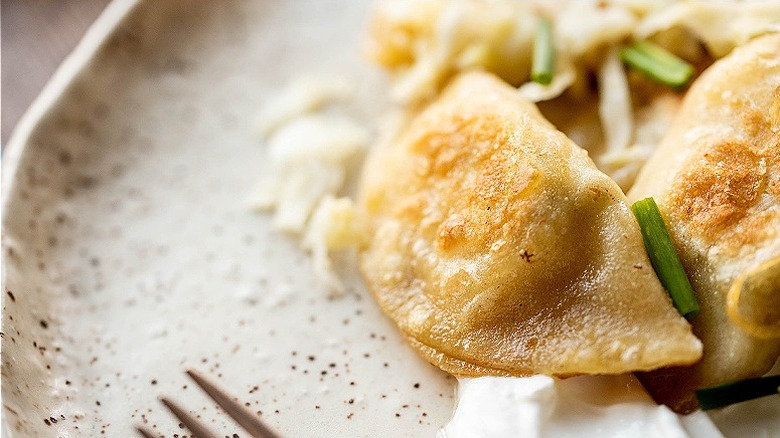Homemade Pierogi Recipe
Every culture has a version of a dumpling: In Japan, there are gyoza, in Italy there are gnudi, and in Spain there are empanadas. Warm filling encased in dough is a universal language that is translated by means of ingredients. Poland's dumplings are simple, chewy, soft potato pockets called pierogi. Similar in shape to Japanese gyoza and close in texture to ravioli, the dense dumpling is steamed or boiled and lightly fried for a soft but crispy finish. Like any dumpling, pierogi are a labor of love that results in a delicious snack or appetizer for a hearty winter meal.
Chicago-born and Cleveland-based recipe developer Michelle McGlinn shares a recipe for a simple, classic Polish pierogi filled with potato and chive and topped with caramelized onion. You can opt to add cheese, herbs, or even the caramelized onions to the potato filling, or keep them simple and load up on toppings like sauerkraut and sour cream. If you have leftover mashed potato laying around, this is the perfect way to reuse them for a delicious warming treat.
Gather your homemade pierogi ingredients
To make pierogi from scratch you'll need flour, egg, olive oil, salt, and water to form a dough. This dough is simple and similar to Italian pasta dough, which gives pierogi a structure much like ravioli. To save time, you can also use premade potsticker wrappers, often found in the freezer section of Asian markets. This dough is similar but slightly thinner and often coated in starch, which causes extra crisping. Pierogi dough is more chewy and dense, so we highly recommend making your own!
For the filling, you'll just need leftover mashed potato, chives, salt, and pepper. If you need to make fresh mashed potato, simply boil a diced potato until soft, then mash with butter until creamy.
For the caramelized onion topping, grab an onion, butter, and sugar. The sugar helps speed up the caramelization, a process that typically requires a long, slow cook time. Once you have the onions caramelized, serve with tangy plain sauerkraut and sour cream for a delicious balance.
Make the dough
If you've made pasta or pizza, you'll recognize this process. Combine the dough ingredients until the ingredients stick together and are workable with your hands. This may look a little funny at first, but once you start kneading, the dough will get smoother. If the dough feels so dry that it crumbles, add water a splash at a time until it resembles play-doh. Knead by pressing the heel of your palm into the dough, turning, and folding the dough in on itself. Repeating the kneading motion again, followed by turning and folding, until the dough is smooth and pliable. This can take 5 to 10 minutes and is important not to skip. Once the dough is smooth, form it into a ball and cover with plastic wrap.
Caramelize the onions
The dough needs time to rest so that the gluten settles and can roll out without snapping or shrinking. During this rest time, prepare the onions. Slice them as thinly as possible — if you don't have a mandolin slicer, use a sharp knife to make thin slices. Thick slices will take longer to caramelize.
Melt the butter in the skillet and add the onions. Don't be tempted to turn the heat up — this will brown the onions, which is delicious but not the super-soft, sweet flavor of caramelization we are going for. Cook the onions on medium low or low heat until they are very soft and caramel colored. If you find yourself needing to add butter, your heat may be too high.
Mix the potato together and roll out the dough
Mix together the mashed potato, seasoning, and chives. If your leftover mashed potato is already seasoned, simply season further to taste. Don't bother reheating the mash, the potato will reheat as the pierogi cooks.
Remove the dough from the plastic and cut it into sections. Flour your surface and your rolling pin and roll the sections into very thin sheets; the dough thickens slightly while cooking, so roll the dough very thin or it will be too chewy when cooked. If the dough is shrinking considerably as you roll, let the dough rest a few minutes longer.
Form and cook the pierogi
Use a biscuit cutter, cookie cutter, or in a pinch, the rim of a glass to cut 2 inch circles out of the thin dough. Wet one side of the circle to bind it, then wrap a small ball of potato in the shell. You'll only need a teaspoon or so of potato in each dumpling – if you add too much, the potato will seep out.
Press the ends of the circle together, wet side against dry side, and press firmly closed. You can crimp the ends with a fork for extra security, or keep it simple and leave it pressed.
Heat a pan over medium heat and add the pierogi. As the pierogi begins to brown, pour in a splash of water and cover to allow the dough to steam. This softens the dough to a silky pliable state. If preferred, you can boil the pierogi instead. With either method, after the dough is cooked, sauté until lightly fried on one side and remove.
Add toppings and serve
Serve the cooked pierogi with your caramelized onions, sauerkraut, extra chives, and sour cream. You can also add bacon bits or bacon jam for a meat version, or serve with cranberry sauce for something sweet. Pierogi are also great for freezing: Form all the pierogi around the potato, then place on a sheet tray and freeze for 2 hours. Once frozen, place raw pierogi in a freezer bag and keep for up to 4 months. The pierogi can be cooked from frozen.
You can also store cooked pierogi in the refrigerator for up to a week. Reheat in the microwave for an easy mid-afternoon potatoey snack!
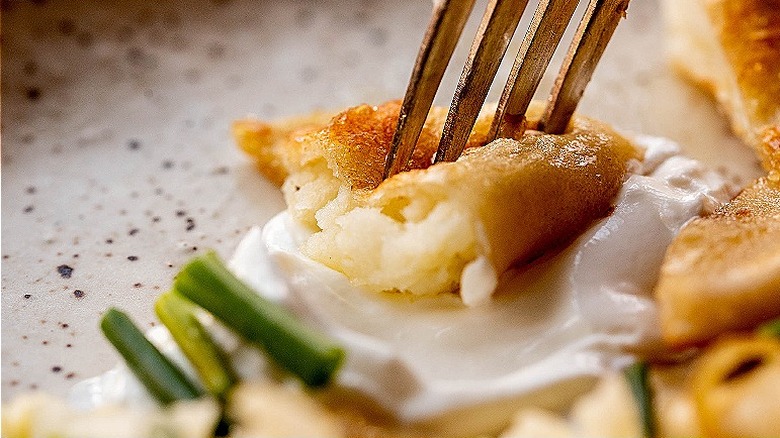
- 2 cups all-purpose flour
- 1 egg
- 4 tablespoons olive oil, divided
- 2 teaspoons salt, divided
- ¾ cup water, divided
- 1 cup mashed potato
- ¼ cup chopped chives, plus more for serving
- ½ tablespoon black pepper
- 1 yellow onion, thinly sliced
- 2 tablespoons butter
- ½ tablespoon sugar
- sour cream, for serving
- sauerkraut, for serving
- Sift the flour into a large bowl and add egg, 2 tablespoons olive oil, and 1 teaspoon salt and use a wooden spoon to combine until clumpy. Add in ½ cup water a splash at a time until dough forms, then combine with hands into a ball. Transfer to a floured work surface.
- Knead the dough until smooth, about 5 minutes. Form it into a ball and cover it with plastic wrap. Let dough rest for 30 minutes at room temperature.
- Meanwhile, melt butter in a small skillet over low heat. Add sliced onions and sugar and cook over low heat until caramelized, about 30 minutes.
- While the dough is resting and the onions are caramelizing, combine mashed potato, chives, 1 teaspoon salt and black pepper in a small bowl. Set aside.
- Once the dough has rested, cut it into sections and roll it into thin sheets. The dough should be the thickness of a penny.
- Using a biscuit cutter or circular cookie cutter, cut 2 to 3-inch circles in the dough. Spoon a teaspoon of mashed potato into the center of each dough circle, then brush water on one half of the circle perimeter and press the sides together to form a crescent shape. Repeat until all the dough is used, storing the pierogi in the refrigerator while you work to avoid sticking.
- When ready to cook, heat a skillet over medium heat. Add a thin layer of oil and the pierogis, working in batches as needed. As the pierogis begin to cook, add 2 tablespoons of water to the skillet and cover to steam. Steam until water is evaporated, then remove the lid and cook until browned on each side.
- Remove from the heat and serve with onions, sour cream, and sauerkraut. Top with chopped chives as desired.
| Calories per Serving | 84 |
| Total Fat | 4.0 g |
| Saturated Fat | 1.3 g |
| Trans Fat | 0.1 g |
| Cholesterol | 10.5 mg |
| Total Carbohydrates | 10.4 g |
| Dietary Fiber | 0.6 g |
| Total Sugars | 0.7 g |
| Sodium | 96.5 mg |
| Protein | 1.6 g |

